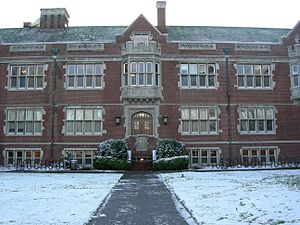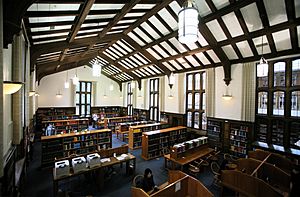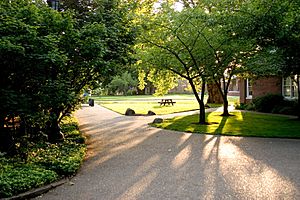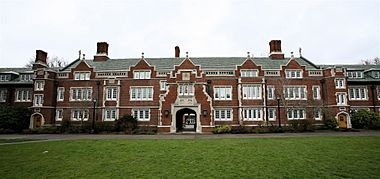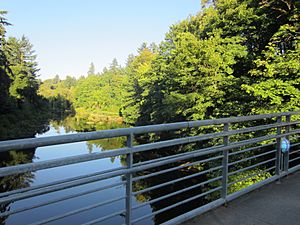Reed College facts for kids
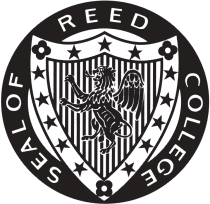 |
|
| Type | Private liberal arts college |
|---|---|
| Established | 1908 |
| Endowment | $814.45 million (2024) |
| President | Audrey Bilger |
|
Academic staff
|
164 |
| Students | 1,358 (fall 2024) |
| Undergraduates | 1,346 (fall 2024) |
| Postgraduates | 12 (fall 2024) |
| Location |
,
,
United States
45°29′N 122°38′W / 45.48°N 122.63°W |
| Campus | Suburban, 116 acres (470,000 m²) |
| Colors | Reed Red |
| Affiliations |
|
| Mascot | Griffin |
Reed College is a private liberal arts college in Portland, Oregon. It was founded in 1908. The school is known for its focus on serious learning and for being different from many other colleges.
Reed is a place where students live on campus. The buildings have a classic Tudor-Gothic style, and there is a forest and canyon in the middle of the campus.
Many of its graduates have become successful scholars and thinkers. Reed is ranked fourth in the United States for the percentage of its graduates who go on to earn a PhD.
Contents
History
Reed College is named after two Oregon pioneers, Simeon Gannett Reed and his wife, Amanda Reed. Simeon was a successful businessman. After he and his wife passed away, they left money in their will to create a college. A local minister, Thomas Lamb Eliot, had encouraged them to do this. The college held its first classes in 1911.
From the very beginning, Reed wanted to be different. It was created as a reaction against the big, famous Ivy League schools on the East Coast. Reed decided not to have sports teams that compete against other schools, and it didn't have social clubs like fraternities and sororities. It was open to both men and women and was not tied to any religion. The goal was to create a place for deep thinking and learning.
Over the years, the college has become known for its students' interest in making the world a better place.
What Makes Reed Special?
Reed College is one of the most unique colleges in the United States. It focuses on liberal arts and sciences. All first-year students must take a special class called Humanities 110. This class is a deep dive into the history and culture of ancient civilizations like Greece and Rome.
No-Grade-Stress Learning
One of the most unusual things about Reed is how it handles grades. Teachers do give students letter grades for their work, but they don't share them with the students. Instead of focusing on a letter like an 'A' or 'B', students get detailed comments on their papers and exams. This helps them focus on learning and improving, not just on getting a good grade.
Students can ask to see their official grades if they need them for things like applying to graduate school. Because of this system, Reed is known for not having grade inflation, which is when grades get higher over time without students necessarily doing better work.
The Senior Thesis
Every student at Reed must complete a thesis before they graduate. A thesis is a big, two-semester research project on a topic the student chooses. They work closely with a professor to guide them.
When the thesis is finished, the student must pass a 90-minute oral defense. This is a meeting where they discuss their project with professors and answer questions about it. It's a challenging but rewarding final step to earning a Reed degree.
A Nuclear Reactor on Campus
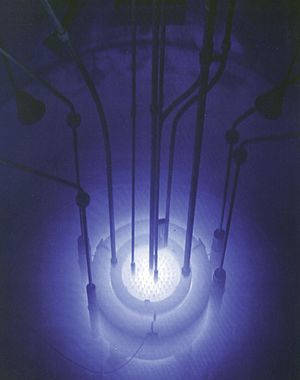
Reed has a TRIGA research reactor right on campus. It is the only college in the United States where a nuclear reactor is run mainly by undergraduate students. This gives science students amazing hands-on experience.
What Can You Study?
Reed divides its subjects into five main areas, called Divisions.
- Division of Arts: This includes Art, Dance, Music, and Theater.
- Division of History and Social Sciences: This includes subjects like History, Economics, and Political Science.
- Division of Literature and Languages: This includes English, Spanish, Russian, and other languages, plus Creative Writing.
- Division of Mathematics and Natural Sciences: This includes Biology, Chemistry, Computer Science, Math, and Physics.
- Division of Philosophy, Religion, Psychology, and Linguistics: This includes the study of how people think, believe, and communicate.
Reed also offers programs that mix different subjects. For example, students can study Biochemistry (a mix of Biology and Chemistry) or History-Literature. The college also has special programs where students can earn a dual degree with other universities in fields like Engineering or Forestry.
Campus Life
The Reed College campus is located on 116 acres in a neighborhood of Portland. The original buildings were designed by architect A. E. Doyle and look like they could be at an old English university. Newer buildings, especially for the sciences, have a more modern style.
Residence Halls
Most Reed students live on campus in one of the 18 residence halls. The dorms come in all shapes and sizes. Some look like old Gothic buildings, while others are modern. There are also special "theme" houses, like language houses where students can practice speaking Spanish or Chinese.
In 2019, the college opened its largest residence hall ever, named Trillium. This building provides housing for 180 students and was built to be very energy-efficient.
Reed Canyon
A natural wetland area called the Reed Canyon runs through the middle of the campus. It's a wildlife preserve with a creek flowing through it. The canyon separates the main academic buildings from some of the dorms.
Twice a year, the college holds "Canyon Day." On this day, students and staff work together to help restore the canyon's natural environment.
Two bridges cross the canyon. The most famous is the "Blue Bridge." In 2008, a new pedestrian and bicycle bridge was built. Students sometimes call it the "Bouncy Bridge."
Student Traditions and Fun
Reed has many fun traditions that make student life unique.
The Griffin Mascot
The official mascot of Reed is the Griffin, a mythical creature with the body of a lion and the head and wings of an eagle. The griffin was on the family coat-of-arms of the college's founder, Simeon Reed. You can see the griffin on the official seal of the college.
The Doyle Owl
One of the most famous traditions is the Doyle Owl. It is a heavy concrete statue of an owl that has been stolen and re-stolen by students since around 1919. The original owl was taken from a neighbor's garden as a prank. Over the years, the original was destroyed, but students have made many replacements. The location of the Doyle Owl is usually a secret, and it appears in surprising places.
Paideia
Every January, before the second semester starts, Reed holds a special one-week event called Paideia. During Paideia, anyone—students, professors, or staff—can teach a class on almost any topic they want. The classes are meant to be fun and low-pressure. Past classes have included everything from underwater basket weaving to building giant concrete gnomes. It's a time for students to learn for the sake of learning and even try teaching something themselves.
Renn Fayre
Renn Fayre is a big, three-day festival held every year at the end of the school year. It started in the 1960s as a Renaissance fair, but now it's a huge celebration with a different theme each year. The festival kicks off with a parade of seniors who toss their thesis notes into a bonfire after they have turned in their final projects.
Famous People from Reed
-
Steve Jobs, founder of Apple Inc.
-
Larry Sanger, co-founder of Wikipedia
-
Gary Snyder, poet
-
Richard Danzig, 71st U.S. Secretary of the Navy
-
James Beard, famous chef
-
Emilio Pucci, fashion designer
Many well-known people have attended Reed.
- Steve Jobs, the co-founder of Apple, attended Reed for one semester. He later said that a calligraphy class he took at Reed inspired the beautiful fonts on the first Macintosh computer.
- Larry Sanger, a co-founder of Wikipedia, graduated from Reed in 1991.
- Gary Snyder, a Pulitzer Prize-winning poet.
- Barbara Ehrenreich, a famous writer and activist.
- James Beard, a celebrated chef and food writer.
- Arlene Blum, a biophysical chemist and famous mountain climber.
See also
 In Spanish: Reed College para niños
In Spanish: Reed College para niños
- List of Reed College people
- List of Reed College buildings


